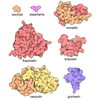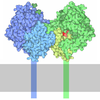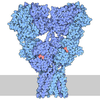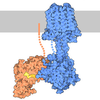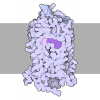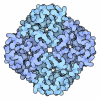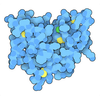+ Open data
Open data
- Basic information
Basic information
| Entry | Database: PDB / ID: 8wgb | ||||||
|---|---|---|---|---|---|---|---|
| Title | mGlu2-4 heterodimer bound with Gi | ||||||
 Components Components |
| ||||||
 Keywords Keywords | MEMBRANE PROTEIN / GPCR | ||||||
| Function / homology |  Function and homology information Function and homology informationadenylate cyclase-inhibiting G protein-coupled glutamate receptor signaling pathway / regulation of response to drug / group II metabotropic glutamate receptor activity / adenylate cyclase inhibiting G protein-coupled glutamate receptor activity / intracellular glutamate homeostasis / behavioral response to nicotine / negative regulation of adenylate cyclase activity / G protein-coupled glutamate receptor signaling pathway / astrocyte projection / neurotransmitter secretion ...adenylate cyclase-inhibiting G protein-coupled glutamate receptor signaling pathway / regulation of response to drug / group II metabotropic glutamate receptor activity / adenylate cyclase inhibiting G protein-coupled glutamate receptor activity / intracellular glutamate homeostasis / behavioral response to nicotine / negative regulation of adenylate cyclase activity / G protein-coupled glutamate receptor signaling pathway / astrocyte projection / neurotransmitter secretion / Class C/3 (Metabotropic glutamate/pheromone receptors) / glutamate receptor activity / GTP metabolic process / glutamate secretion / long-term synaptic depression / regulation of glutamate secretion / cellular response to stress / regulation of dopamine secretion / positive regulation of macroautophagy / Adenylate cyclase inhibitory pathway / regulation of synaptic transmission, glutamatergic / regulation of neuron apoptotic process / presynaptic modulation of chemical synaptic transmission / calcium channel regulator activity / G protein-coupled receptor binding / response to cocaine / adenylate cyclase-inhibiting G protein-coupled receptor signaling pathway / G protein-coupled receptor activity / adenylate cyclase-modulating G protein-coupled receptor signaling pathway / G-protein beta/gamma-subunit complex binding / centriolar satellite / Olfactory Signaling Pathway / Activation of the phototransduction cascade / G beta:gamma signalling through PLC beta / Presynaptic function of Kainate receptors / Thromboxane signalling through TP receptor / G protein-coupled acetylcholine receptor signaling pathway / G-protein activation / Activation of G protein gated Potassium channels / Inhibition of voltage gated Ca2+ channels via Gbeta/gamma subunits / Prostacyclin signalling through prostacyclin receptor / G beta:gamma signalling through CDC42 / Glucagon signaling in metabolic regulation / G beta:gamma signalling through BTK / Synthesis, secretion, and inactivation of Glucagon-like Peptide-1 (GLP-1) / ADP signalling through P2Y purinoceptor 12 / Sensory perception of sweet, bitter, and umami (glutamate) taste / photoreceptor disc membrane / Glucagon-type ligand receptors / Adrenaline,noradrenaline inhibits insulin secretion / Vasopressin regulates renal water homeostasis via Aquaporins / GDP binding / G alpha (z) signalling events / Glucagon-like Peptide-1 (GLP1) regulates insulin secretion / cellular response to catecholamine stimulus / ADORA2B mediated anti-inflammatory cytokines production / ADP signalling through P2Y purinoceptor 1 / G beta:gamma signalling through PI3Kgamma / Cooperation of PDCL (PhLP1) and TRiC/CCT in G-protein beta folding / adenylate cyclase-activating dopamine receptor signaling pathway / GPER1 signaling / Inactivation, recovery and regulation of the phototransduction cascade / cellular response to prostaglandin E stimulus / G-protein beta-subunit binding / heterotrimeric G-protein complex / G alpha (12/13) signalling events / sensory perception of taste / extracellular vesicle / signaling receptor complex adaptor activity / presynapse / Thrombin signalling through proteinase activated receptors (PARs) / presynaptic membrane / GTPase binding / retina development in camera-type eye / Ca2+ pathway / midbody / cytoplasmic vesicle / High laminar flow shear stress activates signaling by PIEZO1 and PECAM1:CDH5:KDR in endothelial cells / fibroblast proliferation / scaffold protein binding / G alpha (i) signalling events / G alpha (s) signalling events / phospholipase C-activating G protein-coupled receptor signaling pathway / gene expression / chemical synaptic transmission / G alpha (q) signalling events / postsynaptic membrane / Ras protein signal transduction / Extra-nuclear estrogen signaling / cell population proliferation / positive regulation of phosphatidylinositol 3-kinase/protein kinase B signal transduction / positive regulation of MAPK cascade / ciliary basal body / G protein-coupled receptor signaling pathway / axon / lysosomal membrane / cell division / GTPase activity / synapse / centrosome Similarity search - Function | ||||||
| Biological species |  Homo sapiens (human) Homo sapiens (human) | ||||||
| Method | ELECTRON MICROSCOPY / single particle reconstruction / cryo EM / Resolution: 3.7 Å | ||||||
 Authors Authors | Zhang, Y. / Liu, J. | ||||||
| Funding support |  China, 1items China, 1items
| ||||||
 Citation Citation |  Journal: Nat Commun / Year: 2024 Journal: Nat Commun / Year: 2024Title: Structural basis of orientated asymmetry in a mGlu heterodimer. Authors: Weizhu Huang / Nan Jin / Jia Guo / Cangsong Shen / Chanjuan Xu / Kun Xi / Léo Bonhomme / Robert B Quast / Dan-Dan Shen / Jiao Qin / Yi-Ru Liu / Yuxuan Song / Yang Gao / Emmanuel Margeat / ...Authors: Weizhu Huang / Nan Jin / Jia Guo / Cangsong Shen / Chanjuan Xu / Kun Xi / Léo Bonhomme / Robert B Quast / Dan-Dan Shen / Jiao Qin / Yi-Ru Liu / Yuxuan Song / Yang Gao / Emmanuel Margeat / Philippe Rondard / Jean-Philippe Pin / Yan Zhang / Jianfeng Liu /   Abstract: The structural basis for the allosteric interactions within G protein-coupled receptors (GPCRs) heterodimers remains largely unknown. The metabotropic glutamate (mGlu) receptors are complex dimeric ...The structural basis for the allosteric interactions within G protein-coupled receptors (GPCRs) heterodimers remains largely unknown. The metabotropic glutamate (mGlu) receptors are complex dimeric GPCRs important for the fine tuning of many synapses. Heterodimeric mGlu receptors with specific allosteric properties have been identified in the brain. Here we report four cryo-electron microscopy structures of mGlu2-4 heterodimer in different states: an inactive state bound to antagonists, two intermediate states bound to either mGlu2 or mGlu4 agonist only and an active state bound to both glutamate and a mGlu4 positive allosteric modulator (PAM) in complex with Gi protein. In addition to revealing a unique PAM binding pocket among mGlu receptors, our data bring important information for the asymmetric activation of mGlu heterodimers. First, we show that agonist binding to a single subunit in the extracellular domain is not sufficient to stabilize an active dimer conformation. Single-molecule FRET data show that the monoliganded mGlu2-4 can be found in both intermediate states and an active one. Second, we provide a detailed view of the asymmetric interface in seven-transmembrane (7TM) domains and identified key residues within the mGlu2 7TM that limits its activation leaving mGlu4 as the only subunit activating G proteins. | ||||||
| History |
|
- Structure visualization
Structure visualization
| Structure viewer | Molecule:  Molmil Molmil Jmol/JSmol Jmol/JSmol |
|---|
- Downloads & links
Downloads & links
- Download
Download
| PDBx/mmCIF format |  8wgb.cif.gz 8wgb.cif.gz | 393.5 KB | Display |  PDBx/mmCIF format PDBx/mmCIF format |
|---|---|---|---|---|
| PDB format |  pdb8wgb.ent.gz pdb8wgb.ent.gz | 308 KB | Display |  PDB format PDB format |
| PDBx/mmJSON format |  8wgb.json.gz 8wgb.json.gz | Tree view |  PDBx/mmJSON format PDBx/mmJSON format | |
| Others |  Other downloads Other downloads |
-Validation report
| Summary document |  8wgb_validation.pdf.gz 8wgb_validation.pdf.gz | 802.2 KB | Display |  wwPDB validaton report wwPDB validaton report |
|---|---|---|---|---|
| Full document |  8wgb_full_validation.pdf.gz 8wgb_full_validation.pdf.gz | 839.8 KB | Display | |
| Data in XML |  8wgb_validation.xml.gz 8wgb_validation.xml.gz | 64.1 KB | Display | |
| Data in CIF |  8wgb_validation.cif.gz 8wgb_validation.cif.gz | 95.9 KB | Display | |
| Arichive directory |  https://data.pdbj.org/pub/pdb/validation_reports/wg/8wgb https://data.pdbj.org/pub/pdb/validation_reports/wg/8wgb ftp://data.pdbj.org/pub/pdb/validation_reports/wg/8wgb ftp://data.pdbj.org/pub/pdb/validation_reports/wg/8wgb | HTTPS FTP |
-Related structure data
| Related structure data |  37507MC  8wg9C  8wgcC  8wgdC M: map data used to model this data C: citing same article ( |
|---|---|
| Similar structure data | Similarity search - Function & homology  F&H Search F&H Search |
- Links
Links
- Assembly
Assembly
| Deposited unit | 
|
|---|---|
| 1 |
|
- Components
Components
-Guanine nucleotide-binding protein ... , 3 types, 3 molecules DEC
| #1: Protein | Mass: 37285.734 Da / Num. of mol.: 1 Source method: isolated from a genetically manipulated source Source: (gene. exp.)  Homo sapiens (human) / Gene: GNB1 / Production host: Homo sapiens (human) / Gene: GNB1 / Production host:  |
|---|---|
| #2: Protein | Mass: 7861.143 Da / Num. of mol.: 1 Source method: isolated from a genetically manipulated source Source: (gene. exp.)  Homo sapiens (human) / Gene: GNG2 / Production host: Homo sapiens (human) / Gene: GNG2 / Production host:  |
| #4: Protein | Mass: 40584.156 Da / Num. of mol.: 1 Source method: isolated from a genetically manipulated source Source: (gene. exp.)  Homo sapiens (human) / Gene: GNAI3 / Production host: Homo sapiens (human) / Gene: GNAI3 / Production host:  |
-Metabotropic glutamate receptor ... , 2 types, 2 molecules BR
| #3: Protein | Mass: 93861.367 Da / Num. of mol.: 1 Source method: isolated from a genetically manipulated source Source: (gene. exp.)  Homo sapiens (human) / Gene: GRM2 / Production host: Homo sapiens (human) / Gene: GRM2 / Production host:  |
|---|---|
| #5: Protein | Mass: 98365.320 Da / Num. of mol.: 1 Source method: isolated from a genetically manipulated source Source: (gene. exp.)  Homo sapiens (human) / Gene: GRM4 / Cell line (production host): HEK293 / Production host: Homo sapiens (human) / Gene: GRM4 / Cell line (production host): HEK293 / Production host:  Homo sapiens (human) / References: UniProt: Q14833 Homo sapiens (human) / References: UniProt: Q14833 |
-Non-polymers , 2 types, 3 molecules 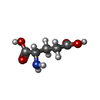
| #6: Chemical | | #7: Chemical | ChemComp-W9R / ( | Mass: 316.180 Da / Num. of mol.: 1 / Source method: obtained synthetically / Formula: C14H15Cl2NO3 / Feature type: SUBJECT OF INVESTIGATION |
|---|
-Details
| Has ligand of interest | Y |
|---|---|
| Has protein modification | Y |
-Experimental details
-Experiment
| Experiment | Method: ELECTRON MICROSCOPY |
|---|---|
| EM experiment | Aggregation state: PARTICLE / 3D reconstruction method: single particle reconstruction |
- Sample preparation
Sample preparation
| Component | Name: mGlu2-mGlu4 heterodimer bound Gi / Type: COMPLEX / Entity ID: #1-#5 / Source: RECOMBINANT |
|---|---|
| Source (natural) | Organism:  Homo sapiens (human) Homo sapiens (human) |
| Source (recombinant) | Organism:  Homo sapiens (human) Homo sapiens (human) |
| Buffer solution | pH: 7.5 |
| Specimen | Embedding applied: NO / Shadowing applied: NO / Staining applied: NO / Vitrification applied: YES |
| Vitrification | Cryogen name: ETHANE |
- Electron microscopy imaging
Electron microscopy imaging
| Experimental equipment |  Model: Titan Krios / Image courtesy: FEI Company |
|---|---|
| Microscopy | Model: TFS KRIOS |
| Electron gun | Electron source:  FIELD EMISSION GUN / Accelerating voltage: 300 kV / Illumination mode: FLOOD BEAM FIELD EMISSION GUN / Accelerating voltage: 300 kV / Illumination mode: FLOOD BEAM |
| Electron lens | Mode: BRIGHT FIELD / Nominal defocus max: 3000 nm / Nominal defocus min: 600 nm |
| Image recording | Electron dose: 52 e/Å2 / Film or detector model: FEI FALCON IV (4k x 4k) |
- Processing
Processing
| CTF correction | Type: NONE |
|---|---|
| 3D reconstruction | Resolution: 3.7 Å / Resolution method: FSC 0.143 CUT-OFF / Num. of particles: 157293 / Symmetry type: POINT |
 Movie
Movie Controller
Controller

















 PDBj
PDBj